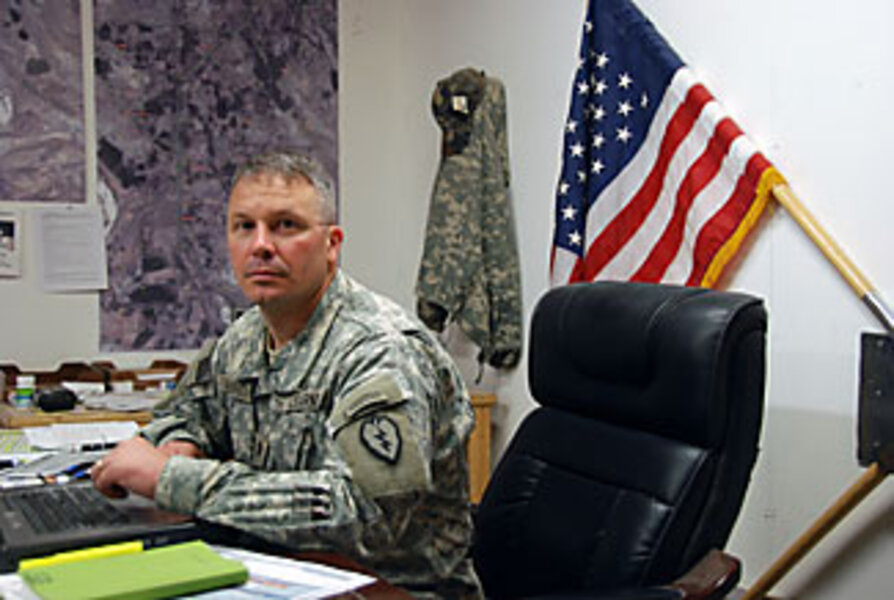How the war in Iraq has shaped a new US military mind-set
Loading...
| Baquba, Iraq
If anything is certain for Lt. Col. Matthew Anderson and the nearly 500 men under his command, it's that they can expect to spend the least amount of their time doing their designated job as artillerymen.
Over the course of the unit's 10 months in Iraq, they've cleared houses rigged with explosives, helped refugees return home, and worked to restore Diyala Province's irrigation system. In the process, they've shifted from a cold-war mind-set of following rigid doctrine to a new approach that requires flexibility and creativity.
When Anderson tasked Capt. Todd Tatum to lead his company in clearing enemy weapons caches in the palm groves outside Naquib, a town in Diyala, the company commander responded with an unexpected request: set fire to the palm groves.
"I was like, 'What?!'" recalls Anderson, who comes off as the friendly guy next door rather than a hardened battle commander.
With the thick undergrowth, the mission would be dangerous. Tatum explained that he could get the landowner's permission and burn away the underbrush without damaging the trees. After some discussion Anderson agreed and managed to get approval from his commanders, who initially shared his first response. The mission became hugely successful and was a critical step that enabled many displaced people to return to Naquib.
Military to cultivate creativity
In Afghanistan and Iraq, the US military has looked to both veteran officers – such as Anderson, who came of age during the cold war – and young lieutenants and captains to adapt and implement new strategies on the fly. As American involvement in Iraq winds down, the military is looking to ingrain those skills in future leaders across its ranks – many of whom earned their chops here.
"We've developed a generation that has ... gained invaluable experience fighting a counterinsurgency, so 10 years from now, if that's where we're at, these young men and women that have served here will be able to go back [to] that experience," says Anderson. "They'll create that culture of out-of-the-box thinking, which is what's needed to be successful rather than the old cookie-cutter solutions."
But ironically, trying to develop a curriculum that teaches the kind of creativity required in a counterinsurgency only succeeds in creating a new doctrine just as rigid as those from the cold war, says James Carafano, a retired US Army lieutenant colonel and former West Point professor.
"[Secretary of Defense Robert Gates] is going to institutionalize what he thinks is creativity and innovation and actually what he's going to be doing is killing creativity and innovation," says Mr. Carafano, currently a senior fellow at the Heritage Foundation, a conservative think tank. "He's focusing on, 'I need people who can really understand counterinsurgency' ... [when] you need people who can be adaptive and creative and can be critical thinkers and decisionmakers."
A shift from the cold war mentality
When Anderson graduated from West Point in 1988, the Berlin Wall was still standing. Though he credits his education with providing general problem-solving skills, his main focus as a cadet was how to deal with the Soviet threat. "When I joined, we really hadn't been in a war since Vietnam. There was Grenada and that was about it," says Anderson. "I was raised in fighting this huge conventional fight against the Soviet Union."
Anderson's first combat experience during Desert Storm was more or less like the big army war he'd been prepared for. As a young lieutenant he commanded a howitzer platoon, maneuvered with a large unit, and fired shells on Iraqi military positions.
But when the US got involved in the Balkans, Anderson began to notice a shift in military operations. As an instructor at the Joint Readiness Training Center (JRTC) in Fort Polk, La., where the Army created miniature Bosnian villages complete with Bosnians and livestock, Anderson would critique mock missions through the "towns."
Although the demands of the Bosnian mission were far from the challenges that would face soldiers in Iraq and Afghanistan, Anderson says that shifting from conventional war to a peacekeeping mission was a pivotal step in later shifting to the counterinsurgency mind-set.
"The thing that I pulled most ... was the US and our role as an honest broker and how to mediate between different parties with certainly different objectives," says Anderson.
US Army Capt. Joey Williams, whose 1-5 Infantry Battalion serves alongside Anderson's 2-8 Field Artillery battalion, was in his first semester at West Point when the Sept. 11 attacks happened and the US moved toward a new type of war. Williams became one of the first students to take the military academy's new counterinsurgency class in preparation for deployment to Iraq or Afghanistan.
"Our core military history courses talked about counterinsurgency as a thing that happened, but not really a conceptual idea that you would actually have to know about," says Williams.
Perhaps the biggest question for the military's future is how many experienced soldiers they'll retain. Like Anderson, who has served four tours in Iraq since the war began in 2003, many soldiers in his unit have deployed multiple times.
Still, Anderson has cause to be optimistic that many experienced soldiers will stay. His unit had a goal to reenlist 61 soldiers. Nearly double that number – 121 – decided to.





